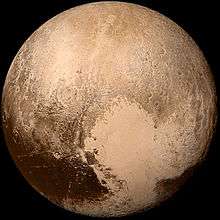2014 OE394
| Discovery | |
|---|---|
| Discovered by | Pan-STARRS (F51) |
| Discovery site | F51, Haleakala Observatory |
| Designations | |
| Classical Kuiper belt object | |
| Orbital characteristics[1] | |
| Epoch 31 July 2016 (JD 2457600.5) | |
| Uncertainty parameter 2 | |
| Observation arc | 1452 days (5 oppositions) |
| Aphelion | 51.976 AU |
| Perihelion | 40.805 ± 0.002 AU |
| 46.391 AU | |
| Eccentricity | 0.12040 ± 0.00005 |
| 316 years | |
| 70.25469° | |
| Inclination | 3.93206 ± 0.00008° |
| 308.87986 ± 0.0004° | |
| 259.35897 ± 0.008° | |
| Physical characteristics | |
| Dimensions |
280-540[1] 240-730[2] |
|
| |
2014 OE394 is a large Cubewano in the Kuiper belt that was discovered in July 2014 by the Pan-STARRS-1 telescope, and announced on July 17, 2016.[3] It is one of the brighter Trans-Neptunian objects, being the 34th brightest Cubewano as of 23 July 2016. Its exact size is unknown, but is most likely between 240 and 730 kilometers across.[2] Mike Brown's website lists it as a "possible" dwarf planet, with an estimated diameter of 337 kilometers.[4]
2014 OE394 is also somewhat close to the New Horizons probe, about 8.7 AU away on January 1, 2017, and 7.5 AU on January 1, 2019. Considering its large size, it would make a possible imaging target, as (15810) 1994 JR1 was in early 2016. However, as 2014 OE394 is currently over 10 times further than the other was, it would have much lower-precision data.
References
- 1 2 "IAU Minor Planet Center - 2014 OE394". Minor Planet Center. International Astronomical Union. Retrieved 24 July 2016.
- 1 2 "JPL Small-Body Database Browser". Jet Propulsion Laboratory. NASA. Retrieved 24 July 2016.
- ↑ "MPEC 2016-O95 : 2014 OE394". Minor Planet Center. International Astronomical Union. Retrieved 24 July 2016.
- ↑ Brown, Mike. "How many dwarf planets are there in the outer solar system? (updates daily)". Mike Brown's Planets. Retrieved 24 July 2016.
_(cropped).jpg)
